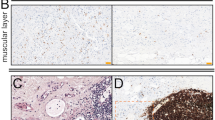Abstract
Precise and accurate light microscopic morphometric analyses of biological tissue can be achieved utilizing component quantitative techniques. Component quantitation refers to measurements of the relative volumes of components in tissue sections. Such an assessment is predicated upon the mathematically verifiable assumption that direct quantitative relationships exist between an aggregate of profiles of a component contained per unit area in multiple sections and an aggregate of profiles contained per unit volume. A linear scanning device (micrometer component quantitator) was initially employed for quantitative analyses of pancreas. This quantitative technique has subsequently been applied to normal rat ileum conventionally processed for light microscopy, and the requisite sampling parameters have been defined. An identical technique was then applied to physiologically manipulated rat ileum—a gnotobiotic group, a group with ileal self-filling blind loops, and a group with ileal Thiry-Vella loops. The results observed support the following conclusions. (1) The volume percentage of the various components of the rat ileal wall of control animals was defined utilizing the micrometer component quantitator. (2) Hypertrophy of the ileal muscularis externa within the ileal self-filling blind loops was observed, probably secondary to mechanical obstruction. (3) Atrophy of the ileal epithelium within the gnotobiotic group and within the Thiry-Vella loops was observed, possibly secondary to an altered endogenous microbial flora. (4) Recognition of quantitative variations among the histological components of the intestinal wall in association with physiological manipulations or pathologic states was (is) feasible by utilization of this component quantitative technique.
Similar content being viewed by others
References
Lazarow A, Carpenter A-M: Component quantitation of tissue sections. I. Characterization of the instruments. J Histochem Cytochem 10:324–328, 1962
Carpenter A-M, Lazarow A: Component quantitation of tissue sections. II. A study of the factors which influence the accuracy of the method. J Histochem Cytochem 10:329–340, 1962
Younoszai MK, Ranshaw JC: Quantitation of intestinal tissue layers from their histology. Am J Dig Dis 20:764–770, 1975
Loria RM, Kibrick S, El-Bermani A-W, Broitman SA: Preparation of intestine and other elongated specimens for histologic and immunofluorescence studies. Am J Clin Pathol 60:424–427, 1973
Rodning CB: A qualitative immunohistochemical and quantitative morphometric analysis of the distribution of intracellular lysozyme and immunoglobulin A in the ileal mucosa ofRattus norvegicus. Doctoral thesis. Department of Anatomy, University of Minnesota, Minneapolis, Minnesota, 1979
Rodning CB, Erlandsen SL, Wilson ID, Carpenter A-M: Light microscopic morphometric analysis of rat ileal mucosa. I. Component quantitation of IgA-containing immunocytes. Dig Dis Sci 28:742–750, 1983
Underwood, EE: Stereology, or the quantitative evaluation of microstructures. J Microsc 89:161–180, 1968
Weibel ER, Bolender RP: Stereological techniques for electron microscopic morphometry.In Principles and Techniques of Electronmicroscopy. MA Hayat (editor). New York, Van Nostrand Reinhold, 1973, pp 237–296
Rodning CB, Wilson ID, Erlandsen SL: Component quantitation of rat ileum. Anat Rec 208:150A, 1984
Cameron DG, Watson GM, Watts LJ: The experimental production of macrocytic anemia by operations on the intestinal tract. Blood 4:803–815, 1949
Bishop RE: Bacterial flora of the small intestine of dogs and rats with intestinal blind loops. Br J Exp Pathol 44:189–196, 1968
Panish JF: Experimental blind loop steatorrhea. Gastroenterology 45:394–399, 1963
Hoet PP, Eyssen A: Steatorrhoea in rats with an intestinal cul-de-sac. Gut 5:309–314, 1964
Kent RH, Summers RW, Den Besten L, Swaner JC, Hronda M: Effect of antibiotics on bacterial flora of rats with intestinal blind loops. Proc Soc Exp Biol Med 132:63–67, 1969
Abrahms GD, Bauer H, Sprinz H: Influence of the normal flora on mucosal morphology and cellular renewal of the ileum. A comparison of germ-free and conventional mice. Lab Invest 12:355–364, 1963
Thompson GR, Trexler PC: Gastrointestinal structure and function in germ-free or gnotobiotic animals. Gut 12:230–235, 1971
Gleeson MH, Cullen J, Dowling RH: Intestinal structure and function after small bowel bypass in the rat. Clin Sci 43:731–742, 1972
Keren DF, Elliott H, Brown GD, Yardley JH: Atrophy of villi and hypertrophy and hyperplasia of Paneth cells in isolated Thiry-Vella ileal loops in rabbits. Gastroenterology 68:83–93, 1975
Thiry L: Ueber eine neue Methode, den Dunndarm zu isolieren Sitzungsberichte der Kaiserlichen. Akad Wiss Math Naturwiss Kl 50:77–96, 1864
Vella L: Nouva metodo per avere succo enterico pure stabilirne le proprieta fisiologiche. Bull Sci Med Bologna 7:441–443, 1881
Author information
Authors and Affiliations
Rights and permissions
About this article
Cite this article
Rodning, C.B., Wilson, I.D. & Erlandsen, S.L. Component quantitation of rat ileum. Digest Dis Sci 31, 428–432 (1986). https://doi.org/10.1007/BF01311681
Received:
Revised:
Accepted:
Issue Date:
DOI: https://doi.org/10.1007/BF01311681




